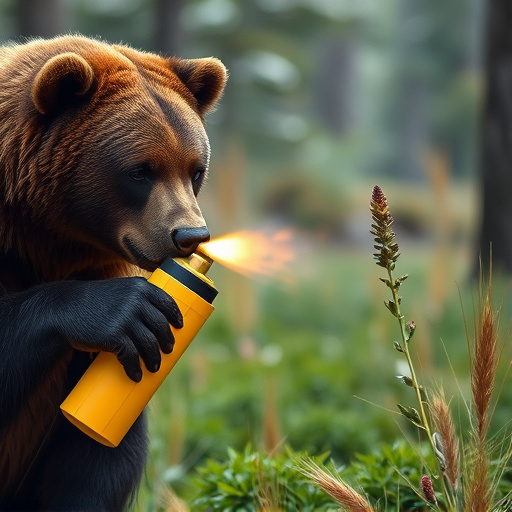When using bear spray in the wilderness, aim from 20 to 30 feet (6 to 9 meters) away, considering wind direction for maximum coverage. Choose canister size based on trip duration and risk level, with larger canisters for extended adventures. Aim high above the bear's head, practice usage, and familiarize yourself with local laws regarding bear spray regulations and storage guidelines.
Bear spray is an essential wilderness safety gear for those adventuring in bear country. This powerful tool can provide a critical defensive layer against aggressive bears, offering users a safe escape at an optimal distance. Understanding its effectiveness, choosing the right canister size, and mastering usage techniques are key to ensuring its reliability when facing a potential encounter. Beyond practical considerations, legal regulations and proper storage play vital roles in maximizing its longevity.
- Understanding Bear Spray Effectiveness
- Choosing the Right Canister Size
- Proper Usage Techniques for Maximum Range
- Legal Considerations and Regulations
- Storage and Maintenance Tips for Longevity
Understanding Bear Spray Effectiveness
Bear spray is a valuable tool for wilderness safety, but understanding its effectiveness and proper usage is crucial. When used correctly, bear spray can create a protective barrier between you and an aggressive bear, providing enough time to escape or climb a tree. However, it’s essential to recognize that bear spray is not a foolproof solution.
The optimal distance for bear spray use varies based on the bear’s behavior and the environment. Generally, it’s most effective when used from a distance of 20 to 30 feet (6 to 9 meters). Beyond this range, the spray may not reach the bear effectively or may have dissipated by the time it does. Additionally, wind direction plays a significant role; spraying into the wind can reduce the spray’s range and coverage, while spraying with the wind can increase its effectiveness.
Choosing the Right Canister Size
When selecting bear spray, one of the crucial considerations is choosing the right canister size. The optimal size depends on several factors, including the user’s preference, intended use, and the specific environment they’ll be navigating. For instance, smaller canisters are ideal for day hikes or as backup options, while larger ones are more suitable for extended wilderness adventures or high-risk areas known for frequent bear encounters.
The recommended optimal distance for bear spray is around 20 to 30 feet (6 to 9 meters). This range ensures that you can effectively defend yourself against an attacking bear without requiring excessive spraying. Smaller canisters may limit your reach, making it challenging to maintain this distance, whereas larger ones offer greater versatility and a longer effective radius. Consider your typical hiking or camping duration and the terrain you’ll be traversing when deciding on a canister size that best suits your wilderness safety needs.
Proper Usage Techniques for Maximum Range
To ensure maximum effectiveness and range, bear spray should be used with precise technique. Aim high, slightly above the bear’s head, to take advantage of the natural breeze that can carry the spray further. The optimal distance for bear spray is around 20-30 feet (6-9 meters), though it can reach up to 35 feet (10.7 meters) in ideal conditions. Holding the canister at waist level and pointing upwards increases the likelihood of achieving this range.
Remember, spraying should be a last resort when facing an aggressive bear. Aim for the eyes and face if possible, as these areas are sensitive. The key is to cover yourself with a dense cloud of spray, creating a barrier between you and the bear. Practice using bear spray in controlled environments to become comfortable with its range and application, ensuring your safety in the wilderness.
Legal Considerations and Regulations
Bear spray is an essential wilderness safety gear, but its use comes with legal considerations and regulations that vary by region. It’s crucial to understand local laws before venturing into bear country. The optimal distance for bear spray usage is a key factor; guidelines typically suggest spraying from a safe distance, often recommended as 20-30 feet (6-9 meters), allowing time to back away or escape while the spray takes effect.
Failure to comply with local regulations, such as improper use or possession without permit, can result in fines or legal consequences. Some areas may have specific requirements for bear spray capacity, expiration dates, and storage. Always check with local wildlife authorities or parks services before heading into the wilderness to ensure you’re carrying the right equipment and using it appropriately.
Storage and Maintenance Tips for Longevity
Proper storage and maintenance are key factors in ensuring your bear spray remains effective and lasts for years to come. Keep it stored in a cool, dry place, away from direct sunlight and extreme temperatures. The optimal distance to store bear spray is at least 100 feet from any camp or food storage areas, as proximity to potential food sources could lead to contamination.
Regularly inspect the can for any signs of damage, corrosion, or leakage. Check the seal and ensure it’s intact. Bear spray should be shaken periodically, typically every few months, to ensure the contents remain mixed and the nozzle remains free of blockages. Always follow the manufacturer’s guidelines for specific maintenance instructions.
Bear spray is a valuable tool for wilderness safety, but its effectiveness relies on understanding its range and proper usage. By choosing the right canister size, learning optimal deployment techniques at the recommended optimal distance for bear spray (typically 20-30 feet), and adhering to legal regulations, you can ensure maximum protection during outdoor adventures. Proper storage and maintenance will also extend the lifespan of your gear, making it a reliable companion in the wilderness.
